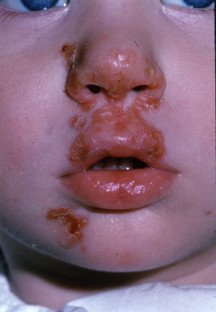Impetigo
Medically reviewed by Drugs.com. Last updated on Dec 16, 2022.
What is Impetigo?

Impetigo is a contagious bacterial skin infection, usually caused by Group A streptococcus or Staphylococcus aureus bacteria. Impetigo is most common in children. However, it sometimes occurs in adults who have other itchy skin conditions, such as eczema. Other conditions that increase your risk of developing impetigo include chickenpox, reactions to insect bites, burns of the skin and diabetes.
Impetigo often appears around the nose and mouth. However, it can develop wherever the skin is broken by cuts, scrapes, scratching, or cold sores, and where bacteria can enter.
|
|
Symptoms
Impetigo causes small bumps or blisters that burst. The skin underneath is moist, tender and red, and it oozes a clear liquid. A honey-colored crust, which may itch, then forms over the reddened area. If the disease is more severe, you also may have a fever and swelling of the lymph glands (swollen glands) in the face or neck.
Diagnosis
A doctor can diagnose impetigo by looking at your skin. In rare cases, your doctor may swab the skin to obtain tissue and fluid that can be tested in a laboratory to identify the bacteria that caused the infection.
Expected duration
Once treatment is started, healing should begin within several days, and the infection should be gone in about a week or two.
Prevention
To help prevent impetigo, take a bath or shower every day, and always keep your skin clean. If you have cuts or scrapes in your skin, or a poison ivy rash, make sure to keep the area clean and avoid scratching.
If you have impetigo, you can prevent spreading the infection by not touching the affected area. You can easily spread the infection from one place on your body to another if you touch the infection then touch somewhere else. To keep impetigo from spreading, it is very important that pillowcases and sheets be washed every day. Personal items, such as soap and towels, should be kept separate from other family members. Playmates who come in contact with infected skin can develop impetigo, so children who have impetigo should try to avoid contact with others until it clears up.
Treatment
Impetigo usually is treated with antibiotics, either in the form of liquid, pills, or an injection. For localized areas of impetigo, your doctor may prescribe a topical antibacterial skin ointment such as mupirocin (Bactroban) or retapamulin (Altabax). The area around the blisters should be washed with soap and water, and any moist, yellow scabs can be gently cleansed with a hydrogen peroxide diluted with water. Covering the area with gauze and tape or a loose plastic bandage can help to reduce the risk of spreading the infection to other parts of the body.
Treatment options
The following list of medications are related to or used in the treatment of this condition.
When to call a professional
If you think you or your child might have impetigo, contact a doctor, especially if either of you has been exposed to someone else with the condition. If impetigo is not treated, it can spread rapidly.
If you or your child is being treated for impetigo, contact the doctor if a fever develops or if an area becomes enlarged or red.
Prognosis
Impetigo should heal without scarring, as long as the child doesn't pick the bumps and blisters. Infants are more likely to develop complications of impetigo, such as inflammation of the kidneys (glomerulonephritis) and infection of the blood (bacteremia).
Additional info
American Academy of Pediatrics (AAP)
https://www.aap.org/
Centers for Disease Control and Prevention (CDC)
https://www.cdc.gov/
Further information
Always consult your healthcare provider to ensure the information displayed on this page applies to your personal circumstances.

